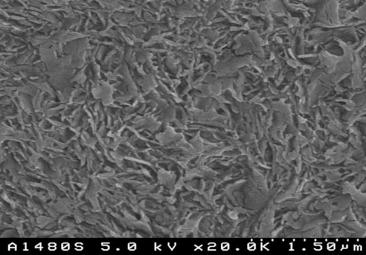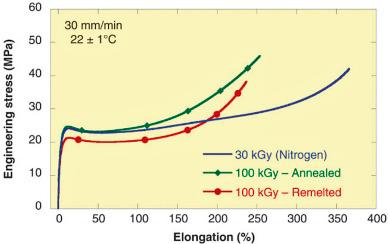Physical Address
304 North Cardinal St.
Dorchester Center, MA 02124
Ultra-high-molecular-weight polyethylene (UHMWPE) remains the polymer bearing material of choice for hard-on-soft joint replacement bearing couples.
Historical UHMWPE formulations were subject to high wear and oxidation-induced embrittlement, resulting in osteolysis and component delamination.
Major improvements in wear and oxidative stability have been achieved through deliberate chemical modifications—primarily, cross-linking and management of free radicals—with concomitant reductions in osteolysis.
Cross-linking improves wear resistance but at the expense of fracture resistance; the compromised fracture resistance must be managed through implant design to minimize stress concentrations (e.g., rims and undercuts in acetabular components).
Future generations of UHMWPE formulations may be modified to incorporate additives to combat or inhibit infection.
Over the years, a variety of bearing couplings have been used in THA, including metal-on-metal and ceramic-on-ceramic, but the most common and enduring combinations in the United States have been metal or ceramic on UHMWPE.
Since the 1960s, UHMWPE has been used as the preferred plastic bearing couple owing to its abrasion resistance (the material is used commercially for cutting boards and dump truck liners for the same reason), toughness, durability, and biologic inertness. This chapter provides a brief overview of the material structure and properties of UHMWPE, beginning with its early “historical” formulations, the concerns with the material in terms of in vivo performance, and the evolution of new formulations of UHMWPE in response to these concerns, including the current state-of-the-art highly cross-linked formulations. The trade-offs in balancing requirements for material stability, wear resistance, and fracture resistance will be considered and potential future directions in materials development for orthopedic devices will be discussed. For a more comprehensive treatise on UHMWPE, the reader is referred to the excellent handbook edited by Steve Kurtz.
Sir John Charnley began performing THA in 1958 using polytetrafluoroethylene (PTFE). The first design included a PTFE head and a thin PTFE acetabular liner. Eventually, the Charnley hip evolved into a cemented metal stem and head bearing against a cemented PTFE acetabular liner and was known as the low-friction arthroplasty (LFA). The first 1 to 2 years of LFA implantation were clinically successful; however, 99% of the implanted hips had to be revised within 2 to 3 years owing to severe wear and an extreme inflammatory response to PTFE wear particles. In May of 1962, a polymer salesman introduced UHMWPE (used at that time for small gears and bushings in machinery) to Harry Craven, Charnley's head technician. Following some additional evaluations, UHMWPE came to be used in Charnley's LFA.
Generically, UHMWPE is a member of the polyethylene family of polymers, including (among others) high-density polyethylene (HDPE) and low-density polyethylene (LDPE). Polyethylene is a linear homopolymer (no branching of chains, 1 repeat unit, or “mer”) based on the ethylene molecule (C 2 H 4 ) wherein the C C double covalent bond is broken, allowing for additive polymerization. Thus, the repeat unit is −(C 2 H 4 )−n (where n indicates the number of repeat units in a polymer chain). Ethylene gas is converted to polyethylene powder resin using the Ziegler process, which requires mixing the ethylene gas with hydrogen and the use of titanium tetrachloride as the catalyst. The powder can then be consolidated into either final or near-final components using direct compression molding or compressed into a sheet or ram-extruded into a rod from which components such as acetabular liners can be machined.
The American Society for Testing and Materials (ASTM D 4020) specifies that UHMWPE, regardless of its intended use, must have a molecular weight (MW) greater than 3.1 million g/mol (resulting in a degree of polymerization of approximately 110,000 repeat units in a polymer chain). The UHMWPE formulations that are used in orthopedic implant components typically have a molecular weight between 2 and 6 ×10 6 g/mol with a degree of polymerization between 71,000 and 214,000, making it perhaps the highest molecular weight high-performance plastic in commercial use. In contrast, the typical molecular weight of HDPE is 0.3 to 0.4 ×10 6 g/mol and poly(methylmethacrylate) bone cement has a molecular weight of about 50,000 g/mol. The specific UHMWPE resins that are used for orthopedic implant components today are GUR 1020 (MW of 3.5 × 10 6 g/mol) and GUR 1050 (MW of between 5.5 and 6 ×10 6 g/mol), both manufactured by Celanese (Bishop, TX and Oberhausen, Germany). Both of these resins are free from calcium stearate, an additive that can be employed with UHMWPE to scavenge for residual catalyst components that can corrode machinery used in manufacturing UHMWPE and that also acts as a lubricating processing agent. Calcium stearate was implicated as being related to fusion defects in UHMWPE orthopedic components; these defects were thought to negatively affect fracture resistance and oxidative resistance, though the argument was controversial. Nonetheless, Celanese modified its production methods such that they were able to discontinue the use of calcium stearate during processing. Today, no orthopedic-grade UHMWPE resin contains calcium stearate.
UHMWPE is also a semi-crystalline polymer, consisting of crystalline and amorphous phases. The crystalline phase contains lamellae that are composed of highly oriented folded chains resulting in an orthorhombic crystalline structure. The lamellae are approximately 10 to 50 nm thick and 10 to 50 µm long. Unlike HDPE, the lamellae in Celanese UHMWPE resins do not form spherulites ; rather, lamellae are oriented randomly within the amorphous phase ( Fig. 5.1 ). The lamellae can be linked to one another and to the amorphous phase with tie molecules and complex interphase (transition) regions. The percent crystallinity of UHMWPE varies from approximately 40% to 75% depending on the formulation, the oxidative state, and the extent of cross-linking.

At body temperature (37°C), UHMWPE is well above its glass transition temperature of approximately −150°C (the temperature at which a polymer transitions from elastic (sometimes referred to as “glassy”) behavior to a more ductile (or “rubbery”) behavior. Thus, when used for joint replacement components, UHMWPE behaves viscoelastically and viscoplastically, meaning that its mechanical behavior shows both strain rate and temperature dependence. The onset of plastic behavior (i.e., the yield point) and the plastic deformation that occurs beyond the yield point involves deformation and possible fragmentation and breakdown of the crystalline regions simultaneously with chain alignment in the amorphous regions. The amorphous regions also contribute to the mechanical behavior of UHMWPE. Kurtz and coworkers determined that the temperature dependence of several mechanical properties of UHMWPE could be modeled using a thermal activation (Arrhenius) relationship. A negative correlation between the activation energies for thermal softening and crystallinity was found. Therefore, they concluded that the decrease in mechanical properties with increasing temperature (e.g., from 20°C to 60°C) was primarily attributable to the amorphous phase of the polymer.
The mechanical and physical properties of UHMWPE materials are specific to the resin used and to the consolidation process; therefore, a range of properties exist for UHMWPE. For example, the as-manufactured density of UHMWPE can vary from 0.930 to 0.945 g/mL. In the absence of deliberate modification (such as cross-linking of the amorphous phase), the tensile yield strength of orthopedic-grade UHMWPE ranges from approximately 19 to 23 MPa, with an elastic modulus of 0.8 to 1.5 GPa, and a ductility (elongation to failure) of 200% to 350%. When cross-linked, the ductility of the material is typically reduced, as is the ultimate strength, though the elastic modulus and yield strength may be little changed ( Fig. 5.2 ). Finally, as will be described in more detail later, the cross-link density of the amorphous phase is the main determinant of wear resistance. This is particularly relevant to contemporary highly cross-linked UHMWPE formulations. Taken together, these properties—combined with a low coefficient of friction against metals, high-impact strength, toughness, ease of fabrication, and biocompatibility—have made UHMWPE the bearing material of choice in total joint replacement (TJR) designs historically and contemporaneously.

Become a Clinical Tree membership for Full access and enjoy Unlimited articles
If you are a member. Log in here